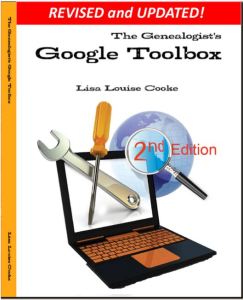Google Alert to Remember Your Wallet? Yep, It’s Coming
 If you’ve read my book The Genealogist’s Google Toolbox, then you know that Google Alerts is an incredibly powerful tool for automating your online genealogy searches and finding things.
If you’ve read my book The Genealogist’s Google Toolbox, then you know that Google Alerts is an incredibly powerful tool for automating your online genealogy searches and finding things.
But l admit it, there are days when I just want to find my reading glasses (typically sitting on my head) or my car keys (I’ll never forget when my kids were toddlers and would hide them in the compartment under the seat of their Big Wheel!) Wouldn’t it be great if your smartphone issued you a Google Alert if you left your keys or eyeglasses behind when leaving the house? It’s a concept under development, based on a new Google patent recently posted on the U.S. Patents and Trademark website.
According to the patent, the device uses short-range wireless technologies to link your smartphone (and who would travel without their smartphone?!) with other commonly-needed items like your wallet, keys or glasses.
According to this article on VentureBeat, “The user can control the amount of distance between the mobile device and the paired object that must exist before an alarm goes off. They can also control the type of alarm, as well as how often the device checks to see if all paired objects remain nearby.”
VentureBeat further comments, “The patent is interesting because it shows Google trying to differentiate Android products by enabling them to directly address some of the little friction points in everyday life. Features such as these may not use cutting-edge technology, but they could sway a consumer to buy an Android product over an iOS product.”
 Speaking of patents….you can find out if your ancestor ever applied for a patent by searching Google Patents for his or her name! Google Patents is also a great place to learn more about the household items and inventions that shaped our relatives’ lives. You can learn more about using Google Patents –and other fabulous and FREE Google tools you can use for family history–in the new, fully-revised 2nd edition of the book The Genealogist’s Google Toolbox.
Speaking of patents….you can find out if your ancestor ever applied for a patent by searching Google Patents for his or her name! Google Patents is also a great place to learn more about the household items and inventions that shaped our relatives’ lives. You can learn more about using Google Patents –and other fabulous and FREE Google tools you can use for family history–in the new, fully-revised 2nd edition of the book The Genealogist’s Google Toolbox.
